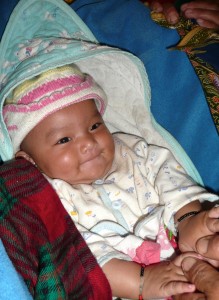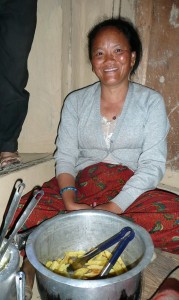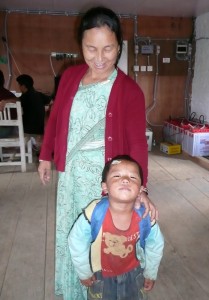I met Lila and Rupa for the first time in 2002. Lila is the Community Health Assistant. She had trained for 18 months in both Kathmandu and Pokhara several years before we met. Rupa is the Certified Health Midwife. She had also trained in Pokhara and Baglung several years earlier also. Neither had been to a continuing medical education class or conference since their training. They practiced medicine in their homes, using a few medications they purchased in Beni, old stethoscopes, government birthing equipment and virtually no supplies…they practiced in a vacuum. Imagine, no matter what your career, never reading an article or talking to another colleague or refreshing your skills. At first I was astounded but as the days wore on and we worked side by side in our makeshift clinic my astonishment turned to awe. They quickly became my heroines…we shared our medical knowledge as I introduced them to the concept of wilderness medicine and they taught me about the Nepalese diseases, treatments and culture.
Lila is the comedian. She can take any situation and find the humor. Nepali people love jokes and the cornier the better….Lila is a master jokester. She views life with excitement and almost manic energy, which sometimes causes commotion in emergencies…but she is surprisingly a realist. It was Lila who stocked the clinic with condoms a few years ago…for the students. She also makes the best French fried potatoes I have ever eaten. Rupa is a careful and thoughtful clinician. She exudes calm as she cares for the really sick patients, such as an asthma patient…who was wheezing herself blue. She is the thinker and comes up with questions and solutions for everything from improving the clinic to the best way to hold down a squiggling kid for stitches. She also makes the tastiest fried, hard-boiled eggs…I know…who would have thought to fry a hard-boiled egg! They were smart, dedicated and creative when it came to making due with limited resources and practicing in a wild environment.

Nangi village infant getting his well baby exam. Afterwards he was placed in his well padded basket, but protested by batting at the shawl covering him…only to settle with his well sucked thumb.
They were the only healthcare providers for the village, which had a population of about 850 people and catchment area of 2500 people. The nearest hospital was in Beni, a six-hour walk from Nangi. They practiced in their homes unless a western practitioner came to Nangi. The two previous volunteer medical doctors had used two connected rooms as a clinic in the abandoned and dilapidated old library building. Each room was about 8 x 5 feet. One was used to stock supplies on make shift wooden shelves, wash our hands in a bucket of water and discuss the diagnosis and treatment plan for each patient. The other room was for examining and treating the patients that boasted a wooden cot for exams. The stock room was adequate, but the exam room posed a challenge…not too bad for one patient and three providers to crowd into…but add the three to six family members that accompanied each patient and it was a regular NYC mid-town bus…during rush hour. No one minded except me, the westerner with a well defined personal boundary, but I quickly learned in Nepal there are no personal boundaries…my space is your space and the more crowed the better. I began to understand it is fueled by curiosity, a willingness to help and the very nature of a society where three or more generations share a home with only one to two rooms. I adjusted…after a few weeks I became such a good personal space invader, that even Darth Vader would have approved.
During the six weeks I lived and worked in Nangi with Lila and Rupa we treated over 600 patients in that little clinic. We provided care for everything from birthing to comfort care for advanced cancer, sutured wounds, pulled teeth, performed minor surgery and educated each patient on hand and toileting hygiene. It was exhausting in the way a well-run marathon feels as you cross the finish line. Join me next week to hear more about these amazing women; their training, families and thoughts about providing care in Nangi.



That’s a lot of patients you saw! Wow, very busy.